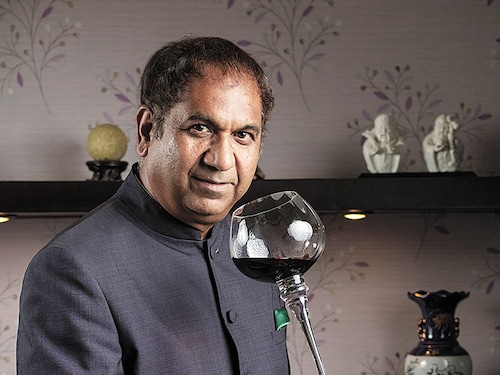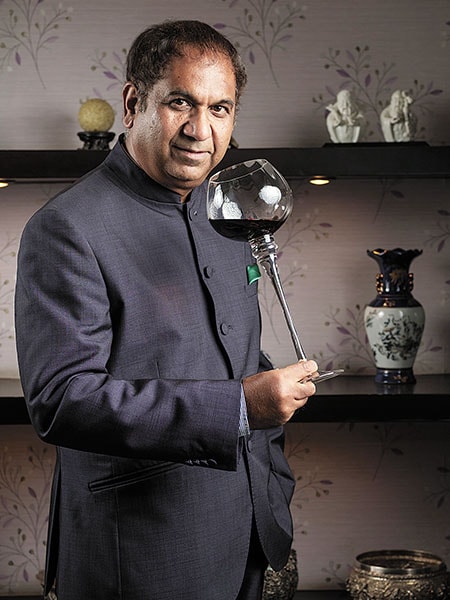Pairing food with wine is overrated: Winemaker Abhay Kewadkar
Abhay Kewadkar, a pioneer of winemaking in India, talks about the evolution of the industry and why wine should not be a snobbish drink


 Abhay Kewadkar launched his label of wines, Early Dark, under Tetrad Global BeveragesAbhay Kewadkar, 58, started working in the wine industry in India when there wasn’t much of an ‘industry’ to begin with. Fresh out of engineering college, not only did he have to learn and master the process of winemaking at his first job at Champagne India Ltd in 1984, he also had to pick up French to work with industry experts in France. Over the decades, he has worked with Indian winemakers such as Chateau Indage, Grover Vineyards, and United Spirits, where he was instrumental in setting up Four Seasons Wines.
Abhay Kewadkar launched his label of wines, Early Dark, under Tetrad Global BeveragesAbhay Kewadkar, 58, started working in the wine industry in India when there wasn’t much of an ‘industry’ to begin with. Fresh out of engineering college, not only did he have to learn and master the process of winemaking at his first job at Champagne India Ltd in 1984, he also had to pick up French to work with industry experts in France. Over the decades, he has worked with Indian winemakers such as Chateau Indage, Grover Vineyards, and United Spirits, where he was instrumental in setting up Four Seasons Wines.
Kewadkar has now launched his own label of wines, Early Dark, under his venture, Tetrad Global Beverages, and is making the first batch of handmade wines in collaboration with Vignobles Arbeau, award-winning winemakers from France. The Arbeau family has been making quality wines for five generations and distributing them to over 30 countries. Early Dark’s portfolio of wines—which includes a Reserve Range of three varietals and blends, and a special Regional Range of another three varietals—has been produced in the vineyards of Sud Quest in France. Edited excerpts from an interview:
Q Your career in the wine industry started in 1984 in a 100 percent export-oriented enterprise, and now you have launched an import-only venture. What brought about this change in focus?
When I started work at Champagne India, there were no vineyards in the country, no technology available for winemaking, and no market. Importing the technology into India was an expensive proposition, but if the product was 100 percent export-oriented, there were no duties on related imports. So, making wine only for export was almost entirely because of economic factors.
After having worked in multiple enterprises in various capacities over the next 35 years, I found myself at a stage when there was nothing new for me to do. The only thing left was to import wines. But here, too, I wanted to do something different from other importers, who simply bring in wines made and bottled by someone else they don’t have their own labels. So that’s what I decided to do.
It helps that we have some excellent friends and collaborators in France. I have known Anne Arbeau [the owner and fourth generation of Vignobles Arbeau] for 20 to 25 years, and she has always wanted to sell wine in India a label that keeps the French heritage. So, we are not selling table wine we are bringing in wines that are IGP [Indication Géographique Protégée, a quality category of French wine] and above.
Q How has global wine production and consumption changed with the growth of new wine regions such as Argentina, Chile, South Africa and California (US)?
Traditionally, wine production was dominated by the ‘Old World’ countries, mostly European. These include France, Spain, Italy and Germany. ‘New World’ wines come from the countries like the ones you mentioned.
The biggest distinction between Old World and New World wines is the manner in which they are labelled: Old World wines are sold by their regions—such as Burgundy, Champagne and Sherry—while New World wines are sold by their varietals [wines made from a particular variety of grapes] such as Cabernet Sauvignon, Chardonnay or Merlot.
Old World wines are labelled like this because of European appellation laws, which categorise wines by their geopolitical boundaries. These laws place a lot of importance on factors such as origin and pairings. New World wines are consumer friendly and uncomplicated. They are labelled in a way that makes it easier for consumers to enjoy them.
Q What is the difference between the Maharashtra and Karnataka wine-growing regions?
The soil and climate of a place give identity to grapes, and therefore, in a broader sense, to wines. The soils of the Nashik region in Maharashtra and that around Bengaluru in Karnataka are different, as is their climate Bengaluru does not have as hot summers or as cold winters as Nashik. This means grapes in the Bengaluru region get a longer ripening season, during which the alcohol level in them will rise much higher compared to the level of tannin. The Nashik region, by comparison, has a shorter ripening season, which keeps alcohol levels lower.
Where the flavour of the grapes—and therefore the wines—is concerned, the regions around Bengaluru are more conducive for making red wines, while the Nashik region is better for producing white wines. The shorter growth cycle of Sauvignon Blanc in Nashik, for instance, will make it more aromatic than the Sauvignon Blanc of Bengaluru.
Q When India started producing wine, there were attempts by the industry to educate consumers on the concept and possibilities of pairing Indian food with wine. Do you think that has succeeded?
The concept of pairing wine with food is overrated. It gives out the message that to enjoy your wine, you have to be very knowledgeable. It is very snobbish. Unlike traditions in the West, in India people drink alcoholic beverages as an aperitif, and not as part of their main meal. So the Western rules cannot apply here.
It is common for whiskey to be had around 8 pm, when it is dark outside. With our brand, Early Dark, we mean to say that you can have wine whenever you want that it’s never too early to drink wine. Our brand is bringing in the heritage of the Old World wines, along with the practicality and ease of the New World.
What is being sold as good wine in the Indian market is too expensive. With our brand, we will be providing AoP [Appellation d’Origine Protégée, a French system of wine classification] wines for much less usual prices are about 30 percent more than ours.
Q Which are your favourite wines?
My favourite wines are those that I like drinking, and those that are worth their price. I don’t drink wines that I want to brag about on Facebook. When you pay more than $60 to $70 for a wine bottle, you are paying for the supply and demand, you are ‘drinking the label’. No wine costs more than $30 to $35 to produce. So I try to pick up bottles that cost between $40 and $70. I like Burgundies, Pouilly-Fumé and Bordeaux. I am not a fan of Pinot Noir, and find them to be overrated and expensive. I like Sauvignon Blanc from Marlborough, Shiraz from Australia, and Cabernet from California.
First Published: Apr 27, 2019, 07:00
Subscribe Now